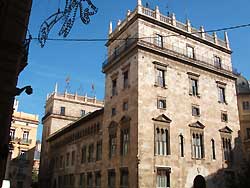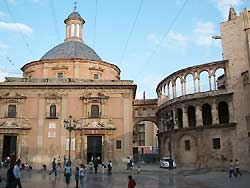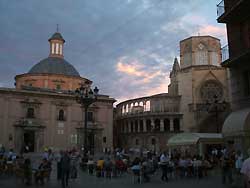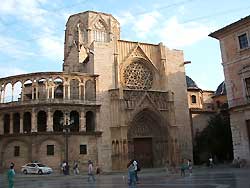|
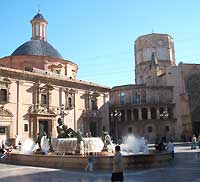
In
the City of Contrasts, Plaza de la Virgin dominates one end of the spectrum
as the counterweight to the City of Arts and Sciences. It is seen by many
as the ultimate impression of the traditional Valencia of the past centuries.
No wonder - Plaza de la Virgin used to be the main square of Valencia,
right from the Roman origins to the day when Plaza de Ayuntamento came
into full swing at the turn of the XX century. It is still a very active
place, with most of the city traditional events passing through here.
The irresistible charm of the Plaza is figured on many postcards and all
the tourists agree that it is simply the best view for having a coffee
on one of the summer terraces.
The Plaza breathes with history, hosting three buildings of huge importance
to Valencians.
Basilica de Virgen de Los Desamparados is the
second most important religious structure after the Cathedral,
one of the first Baroque buildings in Spain and constructed in a traditional
Spanish stye with a blue tiled dome. It is host to the hugely revered
statue of Virgen of the Forsaken
- the patron saint of Valencia. There are various supernatural myths about
this statue. The interior is also very worth seeing.
Palau de Generalitat is the seat of the Valencian
Autonomous Region government, an imposing castle-like structure blending
the late Gothic and Renaissance architecture with Moorish themes.
The rear of the Cathedral
also forms part of the square. The rear turret, the Gothic portal of the
Apostles (where the Water Court meets every Thursday) and the curiuos
colliseum-style colonnade harmonically blend with the Basilica and leave
the tourists entranced.
History: this place has been here always, since
the Roman times. The current look began forming in 13th century with the
construction of the Cathedral, the portal of the Apostles finished in
the frst third of 14th century. In the 15th century the Palau de Generalitat
was built (then a tax office for the Crown) and, finally, in 17th century
- the Basilica. In the beginning of the 20th century the old City Hall
in front of the Palau was taken down and a garden built in its place.
SERVICES
None - public space. Religious
service in the basilica: 8.30, 9.30, 10.30, 11.30, 12.30, 13.30, 17.30,
18.30, 19.30, 20.30 every day. |
 Paginas
Amarillas Paginas
Amarillas
Pz de la Virgen
Carmen
 No access to the Palau. Access
to the Basilica during service times only. For access to the Cathedral
see here.
No access to the Palau. Access
to the Basilica during service times only. For access to the Cathedral
see here.
 Entrance to the Basilica is
free. For the Cathedral prices see here.
Entrance to the Basilica is
free. For the Cathedral prices see here.
Languages
Signs / Content:
n / a
Brochures:
none
Guides:
none
 Map
of Central Sights Map
of Central Sights
Map of Central Walks
|
|

